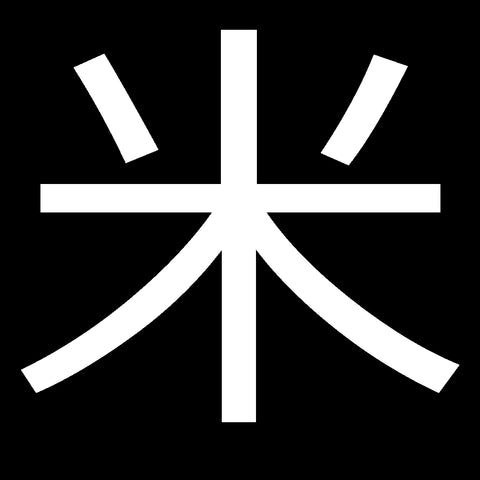The Japanese Philosophy Behind the Character for Rice

The kanji character for rice is 米. It can be dissected as 八 (upside down),十 and 八.
八 (hachi) is kanji for the number eight and 十 (ju) is the kanji for number ten.
So, 八十八 is the number eighty-eight.
In Japan, it is said that to produce rice it requires 八十八の手間 (hachi-ju-hachi no tema), where and 手間 (tema) means time and effort.
Here the number 88 represents “a lot” and 88の手間 indicates that it takes a lot of time and effort to produce rice.
In Nakatsugawa it often took a bit more than “a lot” as various things could become challenging. But the locals never gave up and came up with brilliant countermeasures to keep things going.
Peculiarity of Rice Cultivation in Nakatsugawa
In many places in Japan, rice cultivation starts in early May, but in Nakatsugawa they can’t start because they still have snow on the ground in April and early May. In years with very little snow, the snow will all melt by the end of April, but in years with a lot of snow, it’s even possible to ride a snowmobile in early May. For that reason, farmers typically have to wait until the end of May to start preparing the fields for rice cultivation.
Although Nakatsugawa is located in the southern part of Yamagata Prefecture and the altitude is not very high, there is something about the location of the village that results in some of the deepest accumulations of snow in the country. The surrounding mountains limit the sunlight to a certain extent, which makes it hard to cultivate the type of rice normally produced in other parts of Yamagata Prefecture. So instead people in Nakatsugawa started cultivating a variety that is more commonly used in areas to the north. It was interesting for me to discover that a variety of rice grown in Akita prefecture is also chosen for Nakatsugawa, which is quite a long way south.

The image above shows a family preparing the fields. This photo was taken by Ito Jintaro around 1930.
The lady with the long-handled tool was his wife, and behind you can see their sons. The eldest son is on the far left of the photo and you can see the tiny head of the third son popping out behind the lady holding a round kasa, a traditional Japanese straw hat. That is Ito Tetsuji, and he will be turning 84 this year. In this photo, it is easy to mistake him for a baby being carried by his mother on her back. But he is actually standing behind her, in line with his brothers. This image is from a collection of photos his father took and Tetsuji-san likes this one the best.
Behind the group is a pine tree. That tree is still there, a bit different at the top, but still firmly holding on. So many things have changed, but Tetsuji-san is happy that some things remain the same. The images below were taken in Autumn 2020, and you can see the same tree.


May in Nakatsugawa
Visit Nakatsugawa early in May and you will see a strange sight: a half-submerged forest. Biei in Hokkaido is another place where you can see something like this, but unlike Biei, where the trees are pretty bare, the willows in Nakatsugawa are a vivid green, creating a scene that is serene in a completely different way. You can even paddle among the trees in a canoe, a magical experience.


The surprises Nakatsugawa has to offer in May don’t stop there.
In some years, a little snow may linger until early May. Can you guess what that means?

Yes! You can take photos that include both cherry blossoms and snow. Plus, of course, some of the fresh green that is so beautiful at that time of year. And daffodils. Why daffodils? I will write about them another time.
